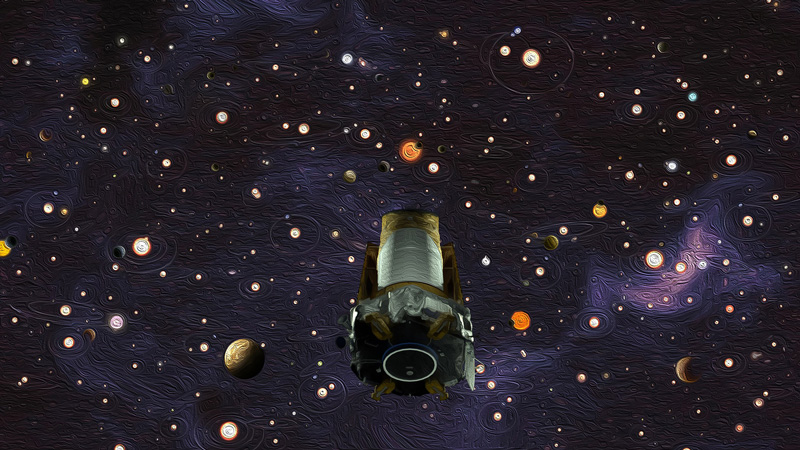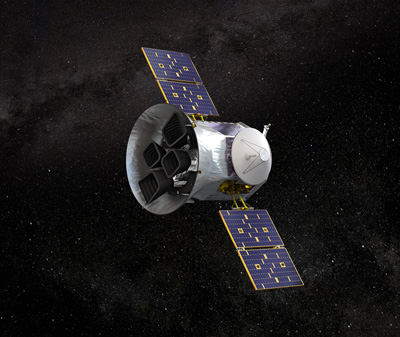A distant planet is in a death spiral and is poised to be engulfed by its parent star.
Kepler-1658b is the first inspiraling planet discovered around an “evolved” star—one that has moved out of its prime life. The star—Kepler-1658—is about 1.5 times the mass of our Sun and has expanded to almost 3 times the Sun’s diameter in its late stages of life, earning it the designation of subgiant.
Should Kepler-1658b maintain its current path, it will meet its fate in about 2.5 million years.
As the complicated discovery of the planet and its star has shown, however, nothing is certain. “It’s a very confounding system,” said Ashley Chontos, a postdoctoral fellow at Princeton University and a member of the team that discovered the planet’s shrinking orbit.
Kepler-1658b was the first exoplanet discovered by the Kepler space telescope, which found thousands of bodies over its lifetime using the transit technique. The telescope measured tiny dips in a star’s brightness when a planet crossed in front of it.

Early in its mission, Kepler recorded such dips from Kepler-1658. However, astronomers had initially cataloged the star as belonging to the main sequence—stars like the Sun that are still burning the hydrogen in their cores. Researchers expected the star to be much smaller than it is, so the initial transit signals “didn’t make sense,” said Shreyas Vissapragada, a postdoctoral researcher at the Harvard-Smithsonian Center for Astrophysics and lead author of the new study. The transit indicated a planet roughly the size of Neptune, our solar system’s third-largest planet. However, the system also produced a secondary eclipse as the planet passed behind the star. At Kepler 1658’s distance, a Neptune-sized planet wouldn’t be bright enough to see, so there would be no evidence of the secondary eclipse.
Kepler-1658b was discarded as a false positive and forgotten about.
“Suddenly, a close-in hot Jupiter made sense.”
That is, until Chontos began looking at vibrations on the surfaces of stars in the Kepler catalog. Because the telescope kept a constant eye on the stars in its field of view, recording brightness levels every half hour or less, it detected “jiggles” caused by sound waves reverberating through the stars. Piecing together the vibrations—a technique known as asteroseismology—revealed details about the stars’ interiors.
In the case of Kepler-1658, they showed that the star was much farther along in life than expected and hence about 3 times bigger. That meant the transiting planet was 3 times larger as well, making it big enough and bright enough to contribute to the system’s overall brightness when it wasn’t eclipsed by the star. “Suddenly, a close-in hot Jupiter made sense,” Chontos said. “That discovery was completely accidental.”
A hot Jupiter is a massive planet comparable to Jupiter—the giant of our own solar system—that orbits so close to its star that it is extremely hot. In this case, Kepler-1658b is about the size of Jupiter, but with almost 6 times its mass. “Even the combined masses of all the planets in [our] solar system don’t add up to that,” Chontos said. The planet orbits its star once every 3.85 Earth days, compared with an 88-day period for Mercury, the Sun’s closest planet.
Changing a Planetary Clock
“The clock had changed—the transits were happening measurably earlier than they were predicted to occur.”
Kepler observed the system for about 4 years, so it obtained a pretty good, but not perfect, measurement of the orbital period. It appeared to show that Kepler-1658b followed a steady path around the star.
At the same time Chontos was studying the system’s vibrations, though, Vissapragada was conducting his own observations. (One night, in fact, he and Chontos bumped into each other during runs at the 200-inch Hale Telescope at Palomar Observatory, where both were looking at the system.)
Vissapragada obtained data from two Hale sessions plus three monthlong sets of observations by the Transiting Exoplanet Survey Satellite (TESS), a space telescope designed to discover and study exoplanets. When combined with the earlier Kepler data, the data provided a 13-year baseline of observations.

“They showed that the clock had changed—the transits were happening measurably earlier than they were predicted to occur,” Vissapragada said. Kepler-1658b’s orbital period was decreasing by 131 milliseconds per year (plus or minus about 20 milliseconds), suggesting the planet will spiral into the star in about 2.5 million years.
The shrinking orbit is probably the result of tidal effects. “We think we know the total energy in the system,” Chontos said. “The planet is depositing energy in the star, causing it to rotate faster and the planet’s orbit to shrink.” A small amount of the system’s total energy could be dissipated in the planet as well, explaining some minor oddities in its orbit, Vissapragada added.
Ruling Out the Alternatives
An inspiral isn’t the only possible explanation for the apparent change in orbital period, however. The timing could appear to change if the system were moving toward us, for example. By measuring the system’s radial velocity—its motion toward or away from us—the team ruled out that possibility. It also ruled out the possibility that we see only part of the orbit’s precession period—a “wobble” in the orbit. “We think we’ve ruled out all other probable causes,” said Vissapragada.
“The evidence for inspiraling planets is plausible, and this paper presents good arguments for this being the case for this planet,” said Girish Duvvuri, a graduate research assistant at the University of Colorado Boulder who has studied the demise of exoplanets but was not involved in this project. “While I can’t say they’ve exhausted all alternative hypotheses, they covered everything I can think of.”
Even so, no one can say the fate of Kepler-1658b is sealed. The process of orbital evolution for planets around evolving stars is poorly understood, so several outcomes are possible.
“The whole dissipation process is very complicated,” Chontos said. “It involves the obliquity, eccentricity, distance—all these different aspects of the orbit that can change over time. While it’s going inward now, there’s nothing to say that the orbit won’t circularize and its migration will stop—just halt. At some point, the planet might even migrate outward. But right now, that’s all just speculation.”
The astronomers hope to narrow down the possibilities with additional observations of the system by TESS and other ground- and space-based telescopes. And they said that finding similar systems will help as well.
“We need to look at more of these systems to pin down exactly how that evolution works,” Vissapragada said. “TESS should give us a lot more examples over the next decade, so we’ll have a fairly large sample to see if this mechanism is common.”
—Damond Benningfield, Science Writer

